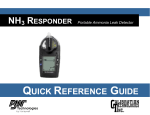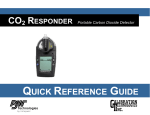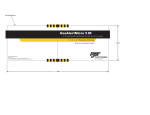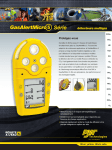Download GasAlertMicro 5 & GasAlertMicro 5 PID
Transcript
Non Printing line GasAlertMicro 5 and GasAlertMicro 5 PID O2, CO, H2S, PH3, SO2, Cl2, NH3, NO2, HCN, ClO2, O3, VOC, and Combustibles 1, 2, 3, 4, and 5 Gas Detectors Quick Reference Guide D5614/5 English iERP: 121273 © 2006 BW Technologies. All rights reserved. Printed in Canada. All product names are trademarks of their respective companies. 11.500" 4.000" Limited Warranty & Limitation of Liability BW Technologies LP (BW) warrants this product to be free from defects in material and workmanship under normal use and service for a period of two years, beginning on the date of shipment to the buyer. This warranty extends only to the sale of new and unused products to the original buyer. BW’s warranty obligation is limited, at BW’s option, to refund of the purchase price, repair, or replacement of a defective product that is returned to a BW authorized service center within the warranty period. In no event shall BW’s liability hereunder exceed the purchase price actually paid by the buyer for the Product. This warranty does not include: a) fuses, disposable batteries or the routine replacement of parts due to the normal wear and tear of the product arising from use; b) any product which in BW’s opinion, has been misused, altered, neglected or damaged by accident or abnormal conditions of operation, handling or use; c) any damage or defects attributable to repair of the product by any person other than an authorized dealer, or the installation of unapproved parts on the product; or The obligations set forth in this warranty are conditional on: a) proper storage, installation, calibration, use, maintenance and compliance with the product manual instructions and any other applicable recommendations of BW; b) the buyer promptly notifying BW of any defect and, if required, promptly making the product available for correction. No goods shall be returned to BW until receipt by the buyer of shipping instructions from BW; and c) the right of BW to require that the buyer provide proof of purchase such as the original invoice, bill of sale or packing slip to establish that the product is within the warranty period. THE BUYER AGREES THAT THIS WARRANTY IS THE BUYER’S SOLE AND EXCLUSIVE REMEDY AND IS IN LIEU OF ALL OTHER WARRANTIES, EXPRESS OR IMPLIED, INCLUDING BUT NOT LIMITED TO ANY IMPLIED WARRANTY OF MERCHANTABILITY OR FITNESS FOR A PARTICULAR PURPOSE. BW SHALL NOT BE LIABLE FOR ANY SPECIAL, INDIRECT, INCIDENTAL, OR CONSEQUENTIAL DAMAGES OR LOSSES, INCLUDING LOSS OF DATA, WHETHER ARISING FROM BREACH OF WARRANTY OR BASED ON CONTRACT, TORT OR RELIANCE OR ANY OTHER THEORY. Since some countries or states do not allow limitation of the term of an implied warranty, or exclusion or limitation of incidental or consequential damages, the limitations and exclusions of this warranty may not apply to every buyer. If any provision of this warranty is held invalid or unenforceable by a court of competent jurisdiction, such holding will not affect the validity or enforceability of any other provision. Contacting BW Technologies USA: 1-888-749-8878 Europe: +44 (0) 1295 700300 Canada: 1-800-663-4164 Other countries: +1-403-248-9226 Email us at: [email protected] Visit BW Technologies’ web site at: www.gasmonitors.com GasAlertMicro 5 & GasAlertMicro 5 PID Introduction Safety Information - Read First This quick reference guide provides basic information for the Use the detector only as specified in this guide, otherwise GasAlertMicro 5 and GasAlertMicro 5 PID. Refer to the user the protection provided by the detector may be impaired. manual on the accompanying CD-ROM for complete operating instructions. The GasAlertMicro 5 and GasAlertMicro 5 PID gas Read the following Cautions before using the detector. detector (“the detector”) warns of hazardous gas at levels above user-selectable alarm setpoints. a Cautions ⇒ Warning: Substitution of components may impair Intrinsic Safety. ⇒ Caution: For safety reasons, this equipment must be operated and serviced by qualified personnel only. Read and understand the user manual completely before operating or servicing. ⇒ Calibrate the detector before first-time use and then on a regular schedule, depending on use and sensor exposure to poisons and contaminants. BW recommends at least once every 180 days (6 months). The detector is a personal safety device. It is your responsibility to respond properly to the alarm. Note The detector is shipped with English as the displayed language. The Portuguese, Spanish, German, and French guides have their screenshots displayed in the corresponding language. 1 GasAlertMicro 5 & GasAlertMicro 5 PID Quick Reference Guide ⇒ ⇒ 2 It is recommended that the combustible sensor be checked with a known concentration of calibration gas after any known exposure to contaminants/poisons (sulfur compounds, silicon vapors, halogenated compounds, etc.). BW recommends to “bump test” the sensors, before each day’s use, to confirm their ability to respond to gas by exposing the detector to a gas concentration that exceeds the alarm setpoints. Manually verify that the audible and visual alarms are activated. Calibrate if the readings are not within the specified limits. ⇒ Only the combustible gas detection portion of this instrument has been assessed for performance by CSA International. ⇒ The combustible sensor is factory calibrated to 50% LEL methane. If monitoring a different combustible gas in the % LEL range, calibrate the sensor using the appropriate gas. ⇒ Caution: High off-scale readings may indicate an explosive concentration. ⇒ Protect the combustible sensor from exposure to lead compounds, silicones, and chlorinated hydrocarbons. Although certain organic vapors (such as leaded gasoline and halogenated hydrocarbons) may temporarily inhibit sensor performance, in most cases, the sensor will recover after calibration. ⇒ For use only in potentially explosive atmospheres where oxygen concentrations do not exceed 20.9% (v/v). ⇒ Any rapid up-scaling reading followed by a declining or erratic reading may indicate a gas concentration beyond upper scale limit, which may be hazardous. ⇒ Extended exposure of the GasAlertMicro 5 and GasAlertMicro 5 PID to certain concentrations of combustible gases and air may stress a detector element, which can seriously affect its performance. If an alarm occurs due to a high concentration of combustible gases, recalibration should be performed, or if needed, the sensor replaced. ⇒ Protect the PID sensor from exposure to silicone vapors. ⇒ The BW pump module (M5-PUMP) is certified for use with the GasAlertMicro 5 and GasAlertMicro 5 PID only. GasAlertMicro 5 & GasAlertMicro 5 PID Parts of the GasAlertMicro 5 & GasAlertMicro 5 PID Parts of the GasAlertMicro 5 & GasAlertMicro 5 PID Item 1 Description Visual alarm bars (LED) 2 Toxic 1/PID sensor 3 Toxic 2 sensor 4 LEL sensor 5 Audible alarms 6 Oxygen sensor 7 Pushbuttons 8 Display (LCD) 9 Battery pack 10 Alligator clip 3 GasAlertMicro 5 & GasAlertMicro 5 PID Quick Reference Guide Display Elements Item 4 Description 1 Alarm condition 2 Automatically span sensor 3 Gas cylinder 4 Gas identifier bars 5 Battery life indicator 6 Pass code lock 7 Data transmission 8 Clock 9 Stealth mode 10 Optional pump indicator 11 Optional datalogger card indicator 12 Alarm condition (low, high, TWA, STEL, or multi-gas) or view TWA, STEL, and maximum gas exposures (MAX) 13 Automatically zero sensor GasAlertMicro 5 & GasAlertMicro 5 PID Pushbuttons Pushbuttons Pushbutton A Description • • • • To turn on the detector press A. To turn off the detector, press and hold A until the countdown is complete. To increment the displayed value or scroll up, press G. To enter the user options menu, press G and H simultaneously and hold until the countdown is complete. G • To clear the TWA, STEL, and maximum (MAX) gas exposure readings, press C and G • To view the date and time, alarm setpoints (TWA, STEL, low, and high) of all the sensors, and simultaneously and hold until the countdown is complete. the LEL/PID correction factor (if applicable), press G. H • • To decrement the displayed value or scroll down, press H. To initiate calibration and setting alarm setpoints, press C and H simultaneously and hold until the countdown is complete. C • • To view the TWA, STEL, and maximum (MAX) hold readings, press C. To acknowledge latched alarms press C. 5 GasAlertMicro 5 & GasAlertMicro 5 PID Quick Reference Guide Calibration Procedure Procedure 4. This option allows the user to select which sensor to span. Use G and H to scroll to a sensor and press C to deselect it. 2. 5. Attach the calibration cap and apply gas at a flow rate of 500 ml/min. K flashes as the unit senses which gas is being applied. flashes while the detector zeroes all of the sensors and calibrates the oxygen sensor. If a sensor failed to auto zero, it will bypass the span. 3. Next, the following three screens appear: - Apply span gas now to calibrate - or press C to select sensor(s) - or press A to skip calibration If no button is pressed, proceed to step #5. If C is pressed, go to step #4. If A is pressed, go to the end of step #6. 6 Display 1. In a clean atmosphere, press and hold C and H simultaneously (as the detector beeps and flashes to the corresponding countdown) to enter calibration. The detector then reads Starting calibration. Sensors should be spanned in the following order: exotics (NH3, ClO2, O3, and Cl2), single gas, quad gas (H2S, CO, O2, and LEL), and lastly PID. After 30 seconds, flashes and a countdown appears while the unit completes the span. 6. Once the span is complete, the following three screens appear: - Calibration successful - Press G to apply a new cal gas - Press H to end span Repeat steps #3-6 to calibrate the remaining sensors. The display then advises to press C to set or A to bypass the calibration due dates. Display GasAlertMicro 5 & GasAlertMicro 5 PID Attach the Gas Cylinder to the Detector Procedure Display Attach the Gas Cylinder to the Detector 7. Press H or G to change the calibration due date. Press C to accept this value and proceed to the next due date. (If a sensor failed or did not span, you cannot change the calibration due date for that sensor.) The display then advises to press C to set or A to bypass the alarm setpoints. 8. Press H or G to change the alarm setpoint. Press C to save the displayed value and proceed to the next setpoint. Set the remaining setpoints. The detector beeps twice at the end of the alarm setpoint stage. 9. Saving calibration displays to indicate that calibration is complete. Note If an O3 or ClO2 sensor is located in the Toxic 2 sensor position, a single gas calibration cap must be used. For complete information and procedures, refer to the GasAlertMicro 5/PID/IR User Manual. The calibration cap should only be used during the calibration process. 7 GasAlertMicro 5 & GasAlertMicro 5 PID Quick Reference Guide Alarms The following table lists the numerous alarms of the detector. Alarm 8 Display Alarm Low Alarm: TWA Alarm: • Fast beep • Fast beep • Slow flash • Slow flash • L and target gas bar flash • L and target gas bar flash • Vibrator alarm activates • Vibrator alarm activates High Alarm: STEL Alarm: • Constant beep • Constant beep • Fast flash • Fast flash • L and target gas bar flash • L and target gas bar flash • Vibrator alarm activates • Vibrator alarm activates Display GasAlertMicro 5 & GasAlertMicro 5 PID Alarms Alarm Multi-Gas Alarm: Display Alarm • Alternating low and high alarm beep and flash • Fast beep and flash • L and target gas bars flash • L and target gas bar flash • Vibrator alarm activates • Vibrator alarm activates Sensor Alarm: Automatic Shutdown Alarm: • One beep every 15 seconds • Eight beeps and flashes • FAIL flashes above the failed sensor • Vibrator alarm temporarily activates Low Battery Alarm: Normal Shutdown: • • • One beep and two flashes every 25 seconds Display Over Range Alarm: (Over Level Exposure) Three beeps and flashes flashes 9 GasAlertMicro 5 & GasAlertMicro 5 PID Quick Reference Guide Alarm Display Alarm Confidence Beep: Pump Alarm: • • Screen flashes: - Pump flow change detected - Check for blocked inlet - or press C to run a pump test • Two fast beeps and alternating flashes • Vibrator alarm activates • L and J icons flash One beep, one flash, and one vibrate every 10 seconds Display MMC Fail Alarm: • One beep every 5 seconds • S icon flashes Note Alarms can be set to be latching or non-latching. To confirm this setting, access the latching alarm option in the user options menu. If the detector is in stealth mode, it only vibrates in alarm mode (the audible and visual alarms are disabled). 10 GasAlertMicro 5 & GasAlertMicro 5 PID User Options Menu • Safe: Enables the display to read Safe if the detector User Options Menu does not enter an alarm; To access the user options menu press and hold G and H • Fast pump: Maximizes the pump speed if the until the detector completes the countdown. sampling hose is longer than 50 ft. (15.24 m). To scroll through the options, press H or G. Press C to Note select the option. The following are the available user options: 1. Exit: Exits the user options menu. 2. Options: • Backlght: Enables the automatic backlight in lowlight conditions; • Confibeep: Enables/disables the confidence beep; • Due-lock: Upon start-up, it prevents the user from operating a detector that is overdue for calibration by requesting a pass code; • Latch: This option allows an alarm to remain active until the user acknowledges the alarm; • Passcode: Prevents unauthorized personnel from having access to the user options menu, calibration Maximizing the pump speed will reduce the battery life. 3. Sensors: • Sens on: Enables/disables the sensor (the detector still operates if a sensor is disabled); • Span gas: Changes the span gas concentration for each sensor; • STEL period: Changes the short-term exposure limit (5-15 minutes; applicable to toxic sensors only); • TWA method: Choose either the OSHA or ACGIH standard of calculating the time-weighted average; • Resolution: Sets the resolution of the gas measurement as either regular or extra (if applicable); function, and alarm setpoint adjust function; 11 GasAlertMicro 5 & GasAlertMicro 5 PID Quick Reference Guide • %vol CH4: Shows the LEL reading in % vol. assuming a methane environment; • Correction: Allows the user to adjust the instrument reading for a specific gas (only applicable to LEL and PID sensors); Maintenance To keep the detector in good operating condition, perform the following basic maintenance as required: • 4. Logger: Allows the user to change the datalogging • Clock: Allows the user to set the date and time for the • Language: Enables the display’s language in the user’s choice of English, French, Spanish, German, or Portuguese. 12 Clean the exterior with a soft damp cloth. Do not use solvents, soaps, or polishes. detector. 6. Keep an operations log of all maintenance, bump checks, calibrations, and alarm events. interval (between 1-127 seconds). 5. Calibrate, bump check, and inspect the detector at regular intervals. • Autocal: Automatic oxygen calibration upon start-up. • Do not immerse the detector in liquids. GasAlertMicro 5 & GasAlertMicro 5 PID Maintenance Replacing the Batteries a Warning: Always turn off the detector before removing the battery pack. The battery packs are hot-swappable, but alkaline batteries inside the pack must be changed in a non-hazardous atmosphere. 1. 2. 3. 4. Open the latch on the bottom of the detector and remove the battery pack by lifting up the end of the pack. Unscrew the two captive screws on the battery pack, open the pack, and replace the three alkaline batteries. Replace the shell and screw the battery pack back together. Insert the battery pack back into place and secure the latch. 13 GasAlertMicro 5 & GasAlertMicro 5 PID Quick Reference Guide Replacing a Sensor or Sensor Filter Item 1 Description Sensor cover 2 Sensor filter 3 Sensors 4 Detector 5 Machine screws (2) Specifications Instrument dimensions: 14.5 x 7.4 x 3.8 cm (5.7 x 2.9 x 1.5 in.) Weight: 370 g (13.1 oz.) Operating and storage conditions Temperature: VOC: -10°C to +40°C (14°F to +104°F) Other gases: -20°C to +50°C (-4°F to +122°F) Humidity: O2: 0% to 99% relative humidity (non-condensing) VOC: 0% to 95% relative humidity (non-condensing) Combustibles: 5% to 95% relative humidity (non-condensing) Cl2: 10% to 95% relative humidity (non-condensing) HCN, ClO2: 15% to 95% relative humidity (non-condensing) Other gases: 15% to 90% relative humidity (non-condensing) Pressure: 95 to 110 kPa 14 GasAlertMicro 5 & GasAlertMicro 5 PID Specifications Alarm setpoints: May vary by region and are user-settable Detection range: O2: 0 – 30.0% vol. (0.1% vol. increments) CO: 0 – 999 ppm (1 ppm increments) CO (TwinTox sensor): 0 – 500 ppm (1 ppm increments) H2S: 0 – 500 ppm (1 ppm increments) H2S (TwinTox sensor): 0 – 500 ppm (1 ppm increments) Combustibles: 0 – 100% LEL (1% LEL increments) or 0 – 5.0% v/v methane PH3: 0 – 5.0 ppm (0.1 ppm increments) SO2: 0 – 150 ppm (1 ppm increments) Cl2: 0 – 50.0 ppm (0.1 ppm increments) NH3: 0 – 100 ppm (1 ppm increments) NO2: 0 – 99.9 ppm (0.1 ppm increments) HCN: 0 – 30.0 ppm (0.1 ppm increments) ClO2: 0 – 1.00 ppm (0.01 ppm increments) O3: 0 – 1.00 ppm (0.01 ppm increments) VOC: 0 – 1000 ppm (1.0 ppm increments) Sensor type: H2S/CO: Twin plug-in electrochemical cell Combustibles: Plug-in catalytic bead VOC: Photoionization detector (PID) Other gases: Single plug-in electrochemical cell O2 measuring principle: Capillary controlled concentration sensor Alarm conditions: TWA alarm, STEL alarm, low alarm, high alarm, multi-gas alarm, over range alarm, sensor alarm, pump alarm, MMC fail alarm, low battery alarm, confidence beep, automatic shutdown alarm Audible alarm: 95 dB at 1 ft. (0.3 m) variable pulsed dual beepers Visual alarm: Dual red light-emitting diodes (LED) Display: Alphanumeric liquid crystal display (LCD) Backlight: Automatically activates whenever there is insufficient light to view the display (if enabled) and during alarm conditions Self-test: Initiated at activation Calibration: Automatic zero and automatic span Oxygen sensor: Automatic span on activation (selectable) User field options: Confidence beep, latching low and high alarms, pass code protection, enable/disable safe display mode, enable/disable fast pump, combustible sensor measurement, sensor disable, TWA and STEL, language selection, enable/disable automatic oxygen calibration, set span concentration values, set STEL calculation period, set TWA method, gas measurement resolution, enable/disable automatic backlight, adjust clock calendar, and set logging rate (datalogger models only). Datalogger units: Contact BW Technologies for a list of approved MMC or SD cards. Battery operating time Toxic, O2, and LEL sensors: 20 hours (three alkaline cells or one rechargeable battery pack) Toxic, O2, LEL, and PID sensors: 10 hours (three alkaline cells or one rechargeable battery pack) 15 GasAlertMicro 5 & GasAlertMicro 5 PID Quick Reference Guide ATEX: CE 0539 g II 1 G EEx ia IIC KEMA 05ATEX 1096X Approved batteries Approved batteries for product (standards IEC 60079-11, EN50020, UL913, C22.2 No. 157) Alkaline: Duracell MN1500 IECEx: Ex ia IIC Temperature Code -20°C ≤ Ta ≤ 50°C T3C (139.8°C) -20°C ≤ Ta ≤ 40°C T4 (129.8°C) -20°C ≤ Ta ≤ 50°C T3B (163°C) -20°C ≤ Ta ≤ 40°C T3C (153°C) ABS Type Approved: VA-348169-X Warranty: 2 years including sensors (1 year NH3 sensor and PID lamp) This equipment has been tested and found to comply with the limits for a Class B digital device, pursuant to Part 15 of the FCC Rules and ICES-003 Canadian EMI requirements. These limits are designed to provide reasonable protection against harmful interference in a residential installation. This equipment generates, uses and can radiate radio frequency energy and, if not installed and used in accordance with the instructions, may cause harmful interference to radio communications. However, there is no guarantee that interference will not occur in a particular installation. If this equipment does cause harmful interference to radio or television reception, which can be determined by turning the equipment off and on, the user is encouraged to try to correct the interference by one or more of the following measures: Approvals Approved by CSA to both U.S. and Canadian Standards • • Approved: Class I, Division 1, Group A, B, C, and D; Class I, Zone 0, Group IIC • Standards: CAN/CSA C22.2 No. 157 and C22.2 152 ANSI/UL – 913 and ANSI/ISA – S12.13 Part 1 • Energizer E91 NiMH rechargeable: M5-BAT01 -20°C ≤ Ta ≤ 50°C T4 Battery charger: GasAlertMicro 5 battery charger First-time charge: 4 hours per battery pack Normal charge: 3-4 hours per battery pack 16 Reorient or relocate the receiving antenna. Increase the separation between the equipment and receiver. Connect the equipment into an outlet on a circuit different from that to which the receiver is connected. Consult the dealer or an experienced radio/TV technician for help. Non Printing line GasAlertMicro 5 and GasAlertMicro 5 PID O2, CO, H2S, PH3, SO2, Cl2, NH3, NO2, HCN, ClO2, O3, VOC, and Combustibles 1, 2, 3, 4, and 5 Gas Detectors Quick Reference Guide D5614/6 English iERP: 123020 © 2006 BW Technologies. All rights reserved. Printed in Canada. All product names are trademarks of their respective companies. 11.500" 4.000"








































